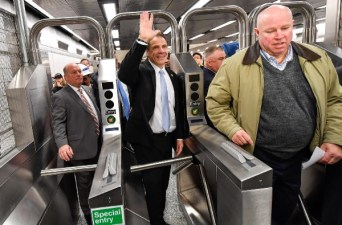IBO: MTA Fares on Pace to Rise 50 Percent Over Next Decade
The 2009 MTA funding package passed by Albany included a plan to increase fares and tolls every other year. The most recent of those fare hikes, implemented in March, increased fares 8.4 percent, with the MTA anticipating another increase in 2015. If this pattern continued for the next decade, fares would rise 50 percent, to $3.75 per ride, according to an analysis by the city’s Independent Budget Office requested by NYPIRG’s Straphangers Campaign [PDF]. Unless city and state leadership act, fares will drastically outpace the inflation rate, even as crossing the East River bridges and driving to the most congested, transit-rich part of the city remains toll-free.

After the introduction of the MetroCard, which brought free bus-to-subway transfers in 1997 and unlimited ride passes in 1998, the average fare paid by riders, adjusted for inflation, fell by more than a third between 1996 and 2002. But since then, “increases in the average fare have outpaced inflation,” IBO says, and the initial gain for straphangers is set to be wiped out by 2027.
If fares kept pace with inflation, the base fare would be $3.25 in a decade — 50 cents less than the IBO projection, which forecasts fares rising 15 percent faster than inflation.
Burdened by debt-financed capital spending and rising health care and pension costs, the MTA’s expenses keep rising, and it has fallen mainly on straphangers to foot the bill.
“Constant fare hikes will overburden riders, discourage use of mass transit, and cannot be sustained over time,” Gene Russianoff of the Straphangers Campaign said in a statement, calling on Governor Cuomo and the legislature to find a solution.
The MTA is under the governor’s control, but a funding solution also needs support from the city’s political establishment. The city’s contribution to the MTA hasn’t increased since 1993, and the value of that contribution has decreased due to inflation. So far, many of the mayoral candidates have been eager to push the funding burden to people who don’t vote for them, by supporting the unlikely reinstatement of the commuter tax. Even John Liu’s bridge toll proposal would give city residents a free ride.
More realistic funding solutions have only attracted the attention of Democrat Sal Albanese, Independence Party candidate Adolfo Carrión, and Republican George McDonald, who have all endorsed a plan to toll traffic on bridges entering the busiest parts of Manhattan, while lowering tolls on bridges between the outer boroughs.
Given the mounting pressure on straphangers, which has received some attention from the Daily News and Times editorial boards recently, it’s time the other mayoral candidates step forward with some realistic proposals.
